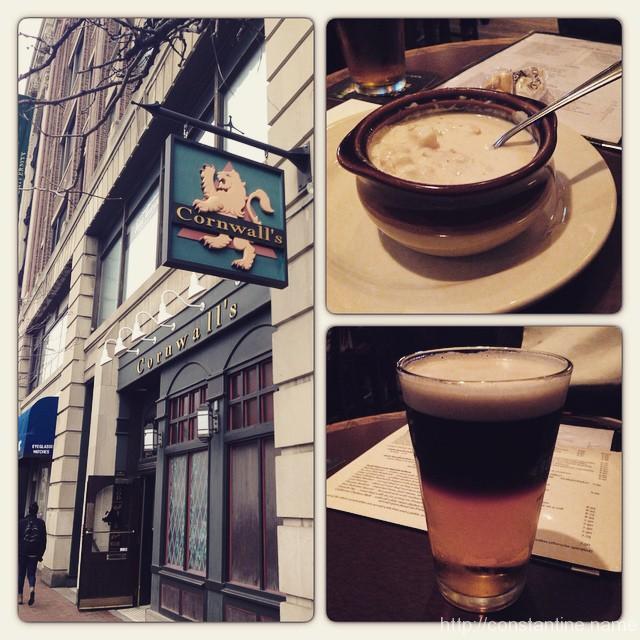If you know, you know. And if you don’t know… well, let’s talk about shrikes.
~ Doug Muir, from Occasional paper: The Suplex Bird
slip:4ucooa1.
I spotted this in RSS, and before I could mark it for later reading, I was halfway through.
ɕ
If you know, you know. And if you don’t know… well, let’s talk about shrikes.
~ Doug Muir, from Occasional paper: The Suplex Bird
slip:4ucooa1.
I spotted this in RSS, and before I could mark it for later reading, I was halfway through.
ɕ
One must have a practice. Because the alternative would be to aimlessly wander.
Ancient Stoicism aimed to be a complete philosophy encompassing ethics, physics and logic. Yet most modern Stoics focus primarily on ethics, and they typically adopt four Stoic principles.
The first is that virtue is the only or highest good, including the cardinal virtues of wisdom, temperance, courage and justice. Everything apart from virtue – including wealth, health and reputation – might be nice to have, but they do not directly contribute to human flourishing.
~ Sandra Woien from, Stoicism and spirituality
slip:4uteso1.
You’ll have to click to read what the other three principles are…
One thing I particular like about the modern Stoicism is that it is explicitly a practice of doing, not of showing. It’s a central point that one should do the work upon oneself without fanfare or proselytizing. Stoicism is aspirational. I share about Stoicism here, in small part because it’d be great for more people to learn about it. But mostly because I often read about it, and thinking and writing about it helps me in my practice.
ɕ
The paragraph above has a topic sentence, then three fragments. Yes, fragments. Like this and the one before it. A fragment is a non-sentence; it does not have a subject and main verb. Students are taught that fragments are errors. Hogwash! Writers use fragments all the time. Your English teacher may not like it and the college admissions office may not either. But, learn to use the fragment.
~ Mylinh Shattan, from The Sentence Fragment
slip:4utete4.
Shattan is writing about writing, and mentions how sentence fragments can hold imagery. I’ve been wondering if this isn’t a critical skill for spoken conversation. Speaking a fragment feels like throwing up a sign post: “Exampleville 15” is helpful in that it gives a definite distance. Deep in a conversation, if I drop in a fragment, it can be a way to indicate I think we’re headed somewhere in particular; fragments can check that are trains of thought still match. Fragments dropped into conversation make sense—like inside jokes—because we’re both on the same journey.
ɕ
Be here now. […] That’s all there is, is what’s happening right now. The fear of the future or the regret of the past has no real bearing in their own place. Just what you’re doing right now.
~ Thomas Droge
slip:4a814.
We’re not just respecting people’s time. We’re respecting their voice and their passion.
~ Seth Godin from, Respecting their time
slip:4usere2.
It’s a good post from Godin. This post of mine is a literal tangent from one thing he mentioned…
In cases where “we’re all going to be speaking” isn’t on the agenda, going around the room, (ala “let’s all introduce ourselves”,) robs people of their agency. I’ve heard it discussed that this wastes time—it does. But vastly worse is the fact that it removes people’s agency.
(Agency is critical. I’ll go out on a limb and say that depriving someone of agency is literally the worst thing you can do to a person. All the horrible physical crimes you just thought of, involve first depriving the victim of their agency. Imagine if taking someone’s agency was treated as the worst crime possible.)
I imagine I’m leading some session, and someone is sitting in the space. When their turn comes around… suppose they don’t want to speak? What if they didn’t want to be heard? By saying, “let’s go around”—even if I say, “and introduce yourself if you want to“—regardless, they are going to be seen. They have to speak, to decline to speak. They have to leave the room, or hide, etc. My “let’s go around the room,” literally robs everyone of their choice.
There are of course lots of situations where “going around” makes perfect sense. For example, if we’re sitting in a restorative justice circle, everyone there knows how it works. You’re free to not speak, and you know that you are going be seen. But the vast majority of times I’ve been in a “let’s go around” situation, it’s the theft of agency variety.
ɕ
Having a clear structure to work in is completely different from making plans about something. If you make a plan, you impose a structure on yourself; it makes you inflexible. To keep going according to plan, you have to push yourself and employ willpower. This is not only demotivating, but also unsuitable for an open-ended process like research, thinking or studying in general, where we have to adjust our next steps with every new insight, understanding or achievement—which we ideally have on a regular basis and not just as an exception.
~ Sönke Ahrens from, How to Take Smart Notes (2017)
I know I’m reading the right thing when—POW—I feel like a whole bunch of loose threads in my mind suddenly make sense. I’m a master at plans and organizing. (Outlines, processes, Allen’s GTD system, etc..) But my current quest for a knowledge system began in earnest when I could no longer ignore the aching feeling that there was something I’m missing; there’s something I’m not doing correctly. Ahren’s point about “imposing structure” on oneself is the insight. There’s a time for that. (And again, I’ve got that sorted.) I’m gleefully skipping off into experimenting with a new structure to work in. This isn’t all clear to me yet, so these blog posts aren’t going to be perfectly clear either. ¯\_(ツ)_/¯
ɕ
slip:4c2ko1a.
That’s what you and I need right now.
~ Steven Pressfield from, Kiwi Virtues in a Time of Trouble
We need the Kiwi virtues.
Nothing fancy. Nothing heroic. Just do our part and be there for our mates in trouble.
slip:4useki1.
I still cannot imagine what the English experienced during the second world war. I’ve long known what, “Keep Calm and Carry On,” was about. But even now that there is a real danger, I still feel zero urge to panic.
Things to do, or not do. Places to go, or not go. Sure. Decisions to be made. People to be helped. Lessons to be learned. Work to be done. Priorities to be reality-checked. Sure.
But, panic? Hoarding? Stigmatizing people? …no thanks.
ɕ
What does it mean to make movement more accessible and inclusive for everyone, regardless of background or athletic ability?
In this episode Cordelia Storm unpacks her thoughts about accessibility, the effects of a gym on a community, and her motivation for learning flips. She delves into her personal journey, as well as her relationship with competition. Cordelia mentions her documentary project, and finishes by tackling the concepts of gender, age, and representation in the parkour space.
In that moment I realized that my voice did matter. Now what? From then on, that just became a big passion— to have people love movement, love feeling their bodies, and like playing.
~ Cordelia Storm (30:55)
The conversation centers on the transformative power of parkour, not just as a physical discipline but as a tool for personal growth, inclusivity, and empowerment. Cordelia Storm shares her journey into parkour, starting from a background in theater and video games, and how the practice helped her overcome personal struggles, including bulimia. A large part of the discussion revolves around how parkour promotes accessibility and how Cordelia works to make movement available to a wider audience. She highlights how parkour shifted her relationship with her body, turning exercise from a punitive activity into a joyful and empowering experience.
Another key topic explored is the emotional impact of losing a community gym and how it challenged the parkour community to adapt and rebuild. Cordelia discusses the importance of outdoor classes and fostering micro-communities within them to maintain connection and continuity. The conversation also touches on gender representation in parkour, the evolving nature of competition, and the broader social and cultural implications of making movement inclusive. Cordelia’s passion for flips and overcoming fear is used as a metaphor for confronting personal barriers, showing how physical challenges in parkour mirror deeper internal struggles and victories.
Takeaways
Losing a community gym — The closure of Parkour Visions’ physical gym space profoundly affected the local community, forcing adaptations in teaching and community building.
Empowering coaches — Building smaller community hubs within classes strengthens the overall parkour community even in the absence of a central gym.
Flips as self-overcoming — Flips in parkour symbolize confronting personal fears and limitations, reflecting broader themes of self-growth and perseverance.
Movement for healing — Parkour provided Cordelia with a path to body acceptance and a healthier self-image after struggling with bulimia.
Representation in parkour — Having visible female athletes and coaches plays a crucial role in encouraging more women to participate in parkour.
The value of competition — Competitions offer opportunities for growth, but can initially feel intimidating and exclusionary, requiring a shift in mindset.
Accessible movement — Parkour needs to be reimagined beyond elite skills, making even basic movements relatable to those new to the discipline.
Emotional vulnerability — Parkour offers men and women spaces to explore vulnerability and overcome ego, fostering deeper emotional intelligence.
Resources
Parkour Visions — The gym and organization where Cordelia started parkour and continues to teach.
Art of Retreat — A parkour leadership gathering frequently referenced in the conversation.
Movement Creative — A community-focused parkour organization associated with Caitlin Pontrella.
APEX School of Movement — A parkour gym where Cordelia worked as head coach.
Vancouver Film School — The institution where Cordelia studied film before discovering parkour.
(Written with help from Chat-GPT.)
ɕ
You’ve gotten your blood test results back, but you have no idea what they mean. Here’s a short overview (from a ketogenic perspective) on how to translate the numbers, and what they mean. The information in the table below will help you sort out the numbers and figure out what you need to address in terms of your health.
~ Ellen Davis from, Your Blood Test Results
slip:4ukebo1.
Nothing heavy today. Just a reference to a short post that is useful for understanding the results of a typical blood test.
ɕ

ɕ

Lunch in Boston! …not shown, pastrami sandwich. *burp*
ɕ
The Misconception: If you stop engaging in a bad habit, the habit will gradually diminish until it disappears from your life.
The Truth: Any time you quit something cold turkey, your brain will make a last-ditch effort to return you to your old ways.
~ David McRaney from, Extinction Burst
slip:4uyoei1.
ɕ
Of the areas I have explored …, I think two in particular stand out for having caused a fundamental rethinking among the aikido community of how our art evolved. … The second is the part played by the Inoue family of Tanabe, especially Morihei’s nephew Yoichiro, in the progression of early events that allowed the Founder to pursue his martial arts career, and eventually develop the art we practice today.
~ Stanley Pranin from, «http://blog.aikidojournal.com/2011/10/30/historical-photo-noriaki-inoue-aikidos-forgotten-pioneer-by-stanley-pranin/»
ɕ

Brown Santa just brought me an Imanishi 8k ceramic waterstone from Lee Valley… “scary sharp”, coming up!
ɕ